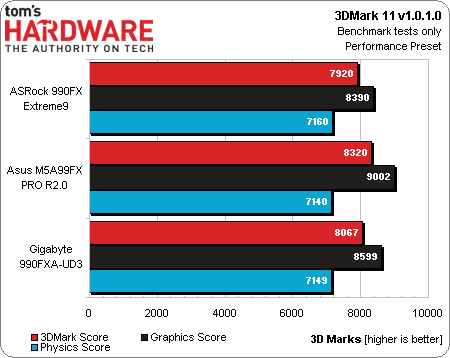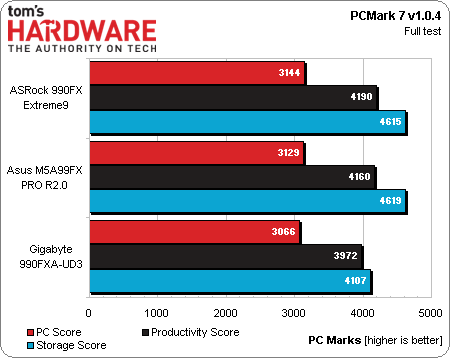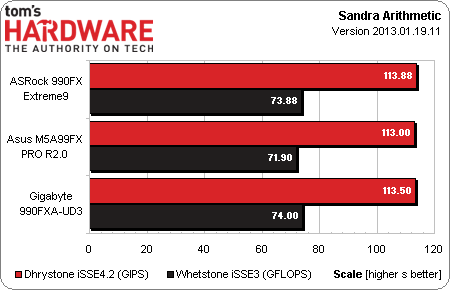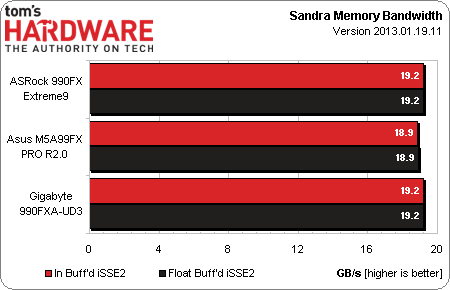Three AMD 990FX-Based Motherboards For Enthusiasts
AMD’s flagship FX-series processors squarely target enthusiasts with sub-$1,000 system budgets, and it's hard to get there with an expensive motherboard. We requested every vendor's top-value solution, and received three boards for your consideration.
Results: Synthetic Benchmarks
I deviated from our normal bare-installation benchmarking to include default manufacturer-supplied software installations in today’s test, looking specifically for the effect of performance and power differences on efficiency. Default should provide the best balance, right?
Asus started off with a modest lead in 3DMark, which was barely large enough to force a retest that proved this advantage consistent.
I was surprised to see Gigabyte fall behind in PCMark’s storage bench. Retests again proved this deficit consistent using AMD’s own AHCI driver on these AHCI-enabled motherboards.
That drop in SATA performance is mainly seen in PCMark’s “Starting Applications” profile. This will have an impact on the system’s overall performance value, since storage makes up 10% of the overall score.
Asus falls a little behind in Sandra’s Encoding/Decoding and Memory Bandwidth test, but this is also the company that usually gets the top DRAM stability scores. Differences this small are a matter of give-and-take.
Get Tom's Hardware's best news and in-depth reviews, straight to your inbox.
Current page: Results: Synthetic Benchmarks
Prev Page Test Settings And Benchmarks Next Page Results: Battlefield 3 And Far Cry 3-
designasaurus "if we diminished most of those power differences by not installing Asus' power management software at default settings, the company would have likely matched the performance of Gigabyte and ASRock."Reply
Don't speculate! Do the tests and add it to the article so we can see what the software packages are actually accomplishing! That's why I read your site, yeah? For hard info that I can't get myself. -
bgunner designasaurus"if we diminished most of those power differences by not installing Asus' power management software at default settings, the company would have likely matched the performance of Gigabyte and ASRock."Don't speculate! Do the tests and add it to the article so we can see what the software packages are actually accomplishing! That's why I read your site, yeah? For hard info that I can't get myself.I totally agree with this statement. The test should have been done and added into the article because this would of been a good representative of the value of the software. I would like to know for a fact if the software was a hindrance to the electrical efficiency of the Asus and Gigabye boards.Reply -
Crashman bgunnerI totally agree with this statement. The test should have been done and added into the article because this would of been a good representative of the value of the software. I would like to know for a fact if the software was a hindrance to the electrical efficiency of the Asus and Gigabye boards.At least the power was measured and mentioned, even if it didn't get into the chart.Reply
-
bit_user AMD's 890FX was an excellent low-cost server platform, in its day. Great I/O, tons of PCIe lanes, 6-channel SATA3, and ECC support. All with boards and CPUs in the desktop price range that were close to being performance competitive with Intel (when they were introduced, at least).Reply
Now, AMD is just slipping too far behind. Not just on the CPU front, but like how about some PCIe 3?
I'm waiting for 64-bit ARMs to hit the desktop. That's probably the next truly interesting thing on the horizon.
-
boulbox Reply10596062 said:Aren't the 990FX chipsets kind old?
Yes, but not a lot of new things need to be offered anyways. PCIe 3.0 is just a gimmick and doesn't really give much more performance over PCIe2 -
Crashman falchardAren't the 990FX chipsets kind old?990FX is AMD's current "high-end" chipset for enthusiast-level desktops. AMD occasionally releases new chips (look last fall) and motherboard companies keep updating their selection of products.Reply
Old chipset, recent boards, any questions?
-
darkchazz "Three AMD 990FX-Based Motherboards For Enthusiasts"Reply
I don't think enthusiasts would want to buy a slow CPU from AMD. -
Onus What did I miss? The ASRock has better features, including 3-way SLI, more USB3.0, an abundance of accessories, uses less power (the only positive efficiency), has higher performance, lower VRM temps; but BOTH of the other two got awards? I noted the comment about fluctuating prices, but on features alone ASRock looks like the winner. Surely it wasn't the slightly lower OC...Reply






